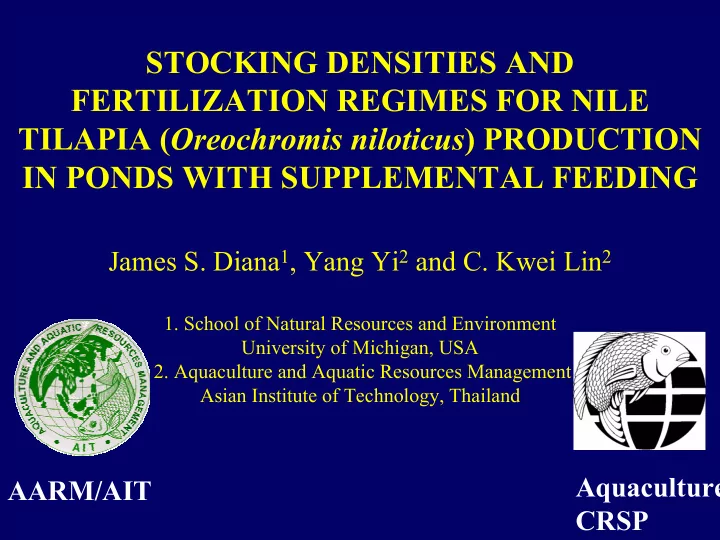

STOCKING DENSITIES AND FERTILIZATION REGIMES FOR NILE TILAPIA ( Oreochromis niloticus ) PRODUCTION IN PONDS WITH SUPPLEMENTAL FEEDING James S. Diana 1 , Yang Yi 2 and C. Kwei Lin 2 1. School of Natural Resources and Environment University of Michigan, USA 2. Aquaculture and Aquatic Resources Management Asian Institute of Technology, Thailand Aquaculture AARM/AIT CRSP
INTRODUCTION � Semi-intensive culture: � Fertilization and supplemental feeding � Roles of supplemental feed in fertilized pond � Increase in fish growth and carrying capacity � Limitation on feeding and increasing stocking density � Poor water quality � Concomitant fertilization might helped maintain reasonable water quality � Stocking density
OBJECTIVE To determine the upper limits to Nile tilapia production utilizing supplemental feeds
MATERIALS AND METHODS Location: Ayutthaya Freshwater Fisheries Station Pond facilities: 9 earthen ponds of 280- m 2 in surface area Culture periods: 155 days (Experiment 1); 194 days (Experiment 2) Test species: Nile tilapia ( Oreochromis niloticus ) Stocking density: 3, 6 or 9 fish·m -2
Stocking size: 18.7 ± 0.2 (Experiment 1), 15.5 ± 0.2 (Experiment 2) Feeding: 50 % satiation rate using floating pelleted feed (30% crude protein) Fertilization: Experiment (1)- Urea 28 kg N·ha -1 ·wk -1 , TSP 7 kg P·ha -1 ·wk -1 Experiment (2)- fertilizer·fish waste balanced input (Approx. 14 kg N · ha -1 · wk -1 and 6 kg P · ha -1 · wk -1 )
RESULTS AND DISSCUSSION The biomass (kg), number, and mean size (g) of Nile tilapia stocked and harvested in each experimental pond for two experiments A t stocking At harvest Pond N um ber Biom ass M ean size N um ber Biom ass M ean size (fish/pond) (kg/pond) (g/fish) (fish/pond) (kg/pond) (g/fish) Experim ent 1 A 1 840 15.4 18.3 737 307.0 416.6 A 2 840 15.5 18.5 744 345.5 464.4 A 3 840 15.0 17.9 745 342.9 460.3 B1 1680 30.2 18.0 1,355 426.3 314.6 B2 1,680 31.8 18.9 1,248 395.5 316.9 B3 1,680 33.0 19.6 1,103 308.5 279.7 C1 2,520 47.9 19.0 1,471 381.4 259.3 C2 2,520 48.0 19.1 1,782 526.3 295.3 C3 2,520 48.7 19.3 1,723 450.3 261.4 Experim ent 2 A 1 840 12.8 15.2 678 335.2 494.4 A 2 840 12.8 15.2 735 445.1 605.6 A 3 840 15.0 14.5 669 313.9 469.2 B1 1,680 26.3 15.6 1,155 502.5 435.1 B2 1,680 26.6 15.8 1,357 652.8 481.1 B3 1,680 26.4 15.7 1,351 567.6 420.1 C1 2,520 38.1 15.1 1,352 417.4 315.0 C2 2,520 40.3 16.0 1,382 452.5 327.4 C3 2,520 41.1 16.3 1,634 533.5 326.5
Mean weights of Nile tilapia during the experiment 1 and 2.
Growth performance of Nile tilapia in each pond in experiment 1 and 2. Growth Survival Net yield Feed applied Annual net yield Pond FCR fish -1 ? day -1 ) ha -1 ? year -1 ) (g? (%) (kg/pond) (kg/pond) (kg? Experiment 1 A1 2.57 87.7 291.6 304 1.04 24,524 A2 2.88 88.6 330.0 332 1.01 27,753 A3 2.86 88.7 327.9 328 1.00 27,577 B1 1.91 80.7 396.1 399 1.01 33,313 B2 1.92 74.3 363.7 410 1.13 30,588 B3 1.68 65.7 275.5 393 1.42 23,170 C1 1.55 58.4 333.5 533 1.60 28,048 C2 1.78 70.7 478.3 566 1.18 40,226 C3 1.56 68.4 401.6 512 1.27 33,775 Experiment 2 A1 2.47 80.7 322.4 463 1.44 21,663 A2 3.04 87.5 432.3 505 1.17 29,048 A3 2.34 79.6 301.7 458 1.52 20,273 B1 2.16 68.8 476.2 624 1.31 32,001 B2 2.40 80.8 626.2 783 1.25 42,080 B3 2.08 80.4 541.2 712 1.32 36,369 C1 1.55 52.6 379.3 590 1.55 25,490 C2 1.61 54.8 412.1 660 1.60 27,701 C3 1.60 64.8 492.4 689 1.40 33,090
Multiple regression results for main effects (density) related to fish growth (g·day -1 ), survival (%), and yield (kg). Variable Coefficient P Experiment 1 Growth Rate (r 2 = 0.811, P < 0.001) Constant 3.42 0.001 Density -0.210 0.001 Survival (r 2 = 0.739, P < 0.001) Constant 0.984 0.001 Density -0.038 0.002 Yield (r 2 = 0.281, P > 0.05) Constant 267.39 0.001 Density 14.66 0.082 Experiment 2 Growth Rate (r 2 = 0.789, P < 0.001) Constant 3.169 0.001 Density -0.172 0.001 Survival (r 2 = 0.736, P < 0.001) Constant 0.978 0.001 Density -0.042 0.002 Yield (r 2 = 0.281, P > 0.05) Constant 366.78 0.006 Density 12.61 0.408
Changes of Chlorophyll- a content in pond water during the experiment 1 and 2.
Changes in alkalinity content of pond water during experiments 1 and 2.
Changes in un-ionized ammonia nitrogen content during experiments 1 and 2.
Changes in dissolved oxygen content of pond water at dawn during experiments 1 and 2.
Calculation of annual profit for each stocking density in both experiments. Urea TSP Feed Gross yield Fish size Profit Density Fry (number) (fish ? m -2 ) (kg) (kg) (kg) (kg) (g) ($) Experiment 1 3 70,645 3,129 1,825 27,037 24,508 447 1,180 6 141,290 3,129 1,825 33,704 38,590 304 - 520 9 211,935 3,129 1,825 45,079 31,434 272 - 7,581 Experiment 2 3 56,443 1,606 1,507 31,999 24,508 523 2,171 6 112,887 1,493 1,197 47,509 38,590 445 - 2,406 9 169,330 1,869 1,584 43,386 31,434 323 - 5,375
CONCULATIONS - The optimal feeding system, most rapid growth, highest survival and positive economic return occurred at the lowest density, 3 fish m -2 . - The fertilizer and fish waste balancing of nutrient inputs successfully controlled nutrient addition and maintained high water quality. - HOWEVER, the reduced fertilization rates probably could not produce adequate natural foods for tilapia. - Further fine-tuning of fertilizer balance may be necessary at each stocking and feeding level.
Recommend
More recommend